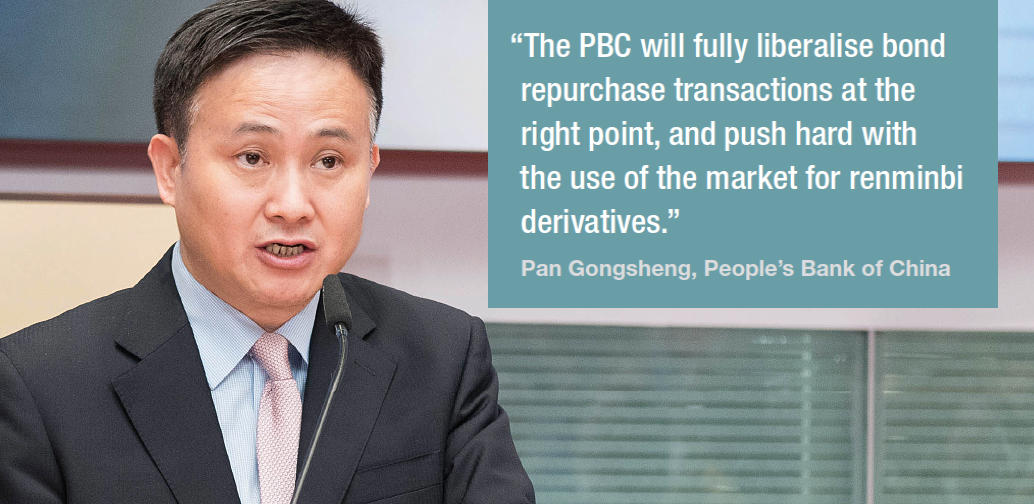Better risk and liquidity management is on the cards for the buy side as repo and derivatives are promoted by authorities and market infrastructure operators.
Hong Kong may see fixed income futures for mainland China bonds launch ahead of expected access to swaps, as authorities and participants in the Chinese bond markets push for better access tools to manage investment positions.
The launch of China Bond Connect in 2017 has allowed mutual trading between the Hong Kong and Mainland markets via a single infrastructure, lowering the barrier to overseas investment firms wising to buy Chinese bonds.
Platform operators including Tradeweb and Bloomberg, who are providing access to Bond Connect, have high levels of engagement with buy-side trading desks planning to connect in future (see the Trading Intentions Survey 2019 p.14). A key further element will be the expansion of access to derivatives via Bond Connect.
Enrico Bruni, head of Europe & Asia business at Tradeweb says, “It is well understood that the development of lending and derivatives markets is a necessary and welcome addition to facilitate more investment in the bond market.”

On 17 January 2019, Pan Gongsheng, deputy governor of the People’s Bank of China (PBC), announced that the mainland market is expected to move this forward. He voiced support for bond index instruments, more effective post-trade infrastructure, and also for FX trading and the fixed income markets.
“The PBC will fully liberalise bond repurchase transactions at the right point, and push hard with the use of the market for renminbi derivatives,” he said, speaking at the China Bond Market International Forum in Beijing.
There are several essential elements to the development of Chinese fixed income markets. Access itself is important. The inclusion of Chinese RMB-denominated government and policy bank securities in the Bloomberg Barclays Global Aggregate Index, which will take a 20-month period to roll out, starting April 2019, will certainly help. Bloomberg estimates the index would include 386 Chinese securities, representing 5.49% of a US$53.73 trillion index, based on January 2018 data.
At present investors who want to access the market can fund themselves in offshore yuan (CNH) or onshore yuan (CNY), the latter facing some restrictions in terms of FX hedging.

“There are some restrictions on CNY for FX and cross currency swaps but I think by April or May most banks would be able to provide that,” says Julien Martin, head of fixed income and currency product development, Hong Kong Exchanges and Clearing (HKEX).
While FX risk is gradually being covered off, in the fixed income space it is currently harder to hedge or to go short against a position. “When it comes to rates, to duration, clearly there is a missing element,” says Martin.
Creating a fully functional repurchase agreement (repo) market to support leveraged trading of bonds, and derivatives to support directional trading, pricing and risk management would help fill this gap.
A rising tide
Activity on Bond Connect shows a growth story. In January 2019, total volume traded was CNY884 billion (US$130 billion, where in 2018 total trading volume was CNY132.3 billion (US$19.5 billion) for the year. Average daily volume (ADV) in January 2019 was CNY6.01 billion, nearly double the ADV for the previous year. As processes bed down and confidence builds, the expectation is that turnover will be enhanced by automation in parts of the trade lifecycle.

“With the introduction of Bond Connect and the trading workflows that are the norm for international investors, we are seeing a significant push onshore among the market makers to accommodate those workflows,” says Li Renn Tsai, head of Asia at Tradeweb. “So while the practice of autoquoting is not widespread onshore right now, that is acknowledged as something that is a necessary development going forward into the future.”
The precursors to inclusion in the Bloomberg Barclays Global Aggregate Index, include an investment grade-rated local currency debt market with currency that is freely tradable, convertible, hedgeable, and free of capital controls, alongside the implementation of delivery versus payment settlement, and the ability to allocate block trades across portfolios.

“Since September we have offered the ability to block execute a transaction and then allocate bonds to multiple accounts,” says Bruni. “From day one we have had an integrated Bond Connect workflow, so for a buy-side user it is essentially the same as the European model. If you have FIX connectivity with Tradeweb you can send US or Chinese bond trade enquiries into the Bond Connect environment.”
Further activity levels are expected to be boosted by the opening of the repo market, which will allow investors leverage
“If we are able to provide repo to offshore investors I think the trading volumes could be increased by seven times,” says Martin.
Next steps
Although sentiment is positive about the use of CNY interest rate swaps (IRS) in the future, credit products are not yet in scope, and authorities are keen to manage how such tools are used. As derivatives have developed in commodity markets, market supervisers have been notably careful to avoid speculators coming in to the market.
“The issue of the moment is that authorities have loosely defined how foreign investors can trade,” says one source, close to the Chinese markets. “They say that Bond Connect allows foreign investors to hedge using IRS, but the timescale is not yet very clear, and they need to work step-by-step to make the IRS curve very liquid. So – with repo and other elements – there are a number of things happening at the same time.”
Martin adds, “Providing access to onshore IRS or bond forwards or is not the ideal solution as these markets are not very liquid in China.”
In a research report published on 30 January, HKEX observed that swap may not be the optimal derivative product to use for overseas investors to use. “[They] trade risk management tools like interest rate swaps, forward rate agreements, bond forwards in the CIBM through Mainland agents, but they also wish to do so through Bond Connect. The Mainland’s exchange-traded market of treasury bonds is currently not open to overseas investors. Even if it is subsequently opened up, overseas investors will have to open and maintain a new set of accounts in the Mainland. This will increase the cost and difficulty of operation, and go against Bond Connect’s philosophy of allowing home market rules for overseas investors,” it noted.
HKEX suggested that policy-makers may “consider permitting the launch of futures products on Mainland bonds in overseas markets,” as an alternative.
Their settlement would be subject to onshore cash bond prices keeping them under mainland influence, thereby controlling risks, it argued.
Better risk management and transfer
“Overseas derivatives like futures on mainland bonds can help investors to do risk management without the need to adjust their cash bond positions,” HKEX wrote in the report. “This would effectively reduce substantial changes to bond positions or frequent cross-border capital flows triggered by market shocks and therefore help maintain stability in the Mainland’s domestic bond market.”
As a ‘second-to-home pilot market’ it advocated Hong Kong as a location to try out those futures, without impacting the opening up activity that is ongoing in the mainland market.
“For bond futures, there will be some impact on the actual [investment] flows into China, but they will be relatively segregated from the actual flow in,” says Martin. “It’s easy to get Bond Connect access for cash bonds. Leverage can be obtained through repo. So the bond future I see more as a tool for people who want to short the market, rather than people who want to be long the market. The future is focused on rates, so we are not going to be talking about short in the credit side.”
Since the Chinese market has only allowed credit defaults over the last three years, there is no real onshore credit default swap (CDS) market today.
“No one writes protection, there is no real mechanism to transfer the credit risk from one entity to the other,” Martin says. “Right now if you look at the protection side of writing and buying, the main interest would be between the offshore guys and the onshore guys. I think it’s a two- to three-year play to get a decent product there. There is a lot of demand from the offshore investors, the problem is more on the liquidity of the credit products themselves.”
©The DESK 2019
©Markets Media Europe 2025

























